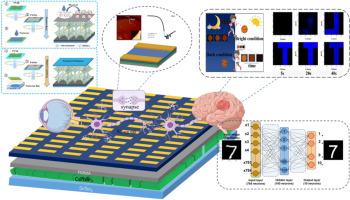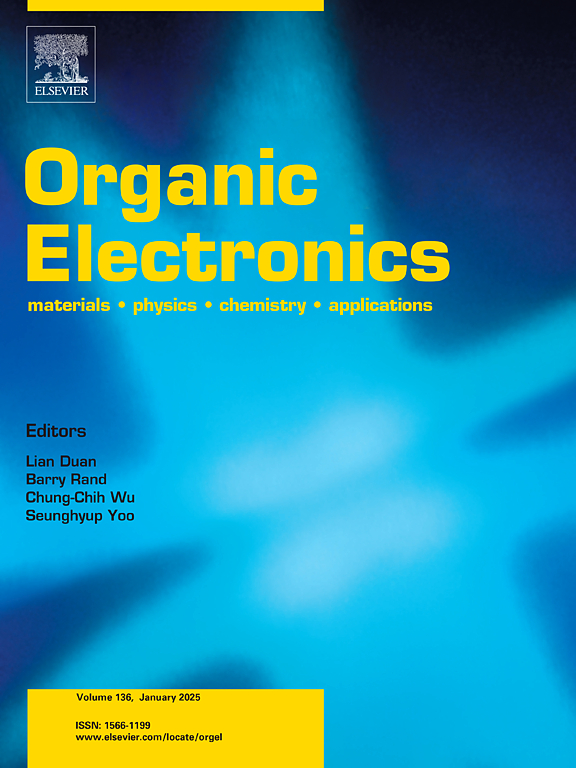Multifunctional heterojunction synaptic transistors based on transferred organic semiconductor crystals for superior visual adaptation
IF 2.6
4区 工程技术
Q3 MATERIALS SCIENCE, MULTIDISCIPLINARY
引用次数: 0
Abstract
Photoelectronic transistors had attracted significant attention in the field of neuromorphic computing, as they integrated efficient sensing, memory, and processing capabilities into a single device. The design of multilayer heterostructures offered novel opportunities for developing multifunctional optoelectronic devices, particularly for neuromorphic optoelectronic devices that required integrated non-volatile memory and excellent optical response characteristics. TIPS-pentacene films with High-quality were successfully prepared through liquid surface growth and evaporation crystallization, and these films were further transferred to target substrates for heterostructure devices. Based on this strategy, a CsPbBr3/PMMA/TIPS-pentacene heterojunction photoelectronics transistor was developed to overcome the limitations of traditional solution-based strategies for preparing multilayer structures. Owing to the ultra-thin and high-quality TIPS-pentacene conductive layer and its excellent interface contact with the underlying film, the composite transistor demonstrated high electrical properties, including high mobility and low subthreshold swing. It exhibited typical synaptic characteristics such as pulse-promotion facilitation (PPF). The device also delivered excellent non-volatile memory characteristics, with multi-state memory windows observed under different gate scanning ranges. Based on the strong gate modulation, the photoelectronic transistor array successfully simulated the dark and bright adaptation behaviors of the human visual system. Therefore, the preparation strategy for multifunctional photoelectronic transistors proposed in this work provided an unique perspective for the next generation of artificial neural systems.

基于转移有机半导体晶体的多功能异质结突触晶体管具有优异的视觉适应性
光电子晶体管在神经形态计算领域引起了极大的关注,因为它们将高效的传感、记忆和处理能力集成到一个单一的设备中。多层异质结构的设计为开发多功能光电器件,特别是需要集成非易失性存储器和优异光响应特性的神经形态光电器件提供了新的机会。通过液面生长和蒸发结晶制备了高质量的tips -并五苯薄膜,并将其转移到异质结构器件的靶衬底上。基于该策略,开发了CsPbBr3/PMMA/ tips -五苯异质结光电子晶体管,克服了传统的基于溶液的多层结构制备策略的局限性。由于超薄、高质量的tips -并五烯导电层及其与底层薄膜的良好界面接触,该复合晶体管具有高迁移率和低亚阈值摆幅的高电学性能。表现出典型的脉冲促进促进(PPF)等突触特征。该器件还提供了出色的非易失性存储特性,在不同的栅极扫描范围下观察到多状态存储窗口。基于强栅极调制的光电晶体管阵列,成功地模拟了人类视觉系统的明暗适应行为。因此,本文提出的多功能光电晶体管的制备策略为下一代人工神经系统提供了一个独特的视角。
本文章由计算机程序翻译,如有差异,请以英文原文为准。
求助全文
约1分钟内获得全文
求助全文
来源期刊

Organic Electronics
工程技术-材料科学:综合
CiteScore
6.60
自引率
6.20%
发文量
238
审稿时长
44 days
期刊介绍:
Organic Electronics is a journal whose primary interdisciplinary focus is on materials and phenomena related to organic devices such as light emitting diodes, thin film transistors, photovoltaic cells, sensors, memories, etc.
Papers suitable for publication in this journal cover such topics as photoconductive and electronic properties of organic materials, thin film structures and characterization in the context of organic devices, charge and exciton transport, organic electronic and optoelectronic devices.
 求助内容:
求助内容: 应助结果提醒方式:
应助结果提醒方式:


